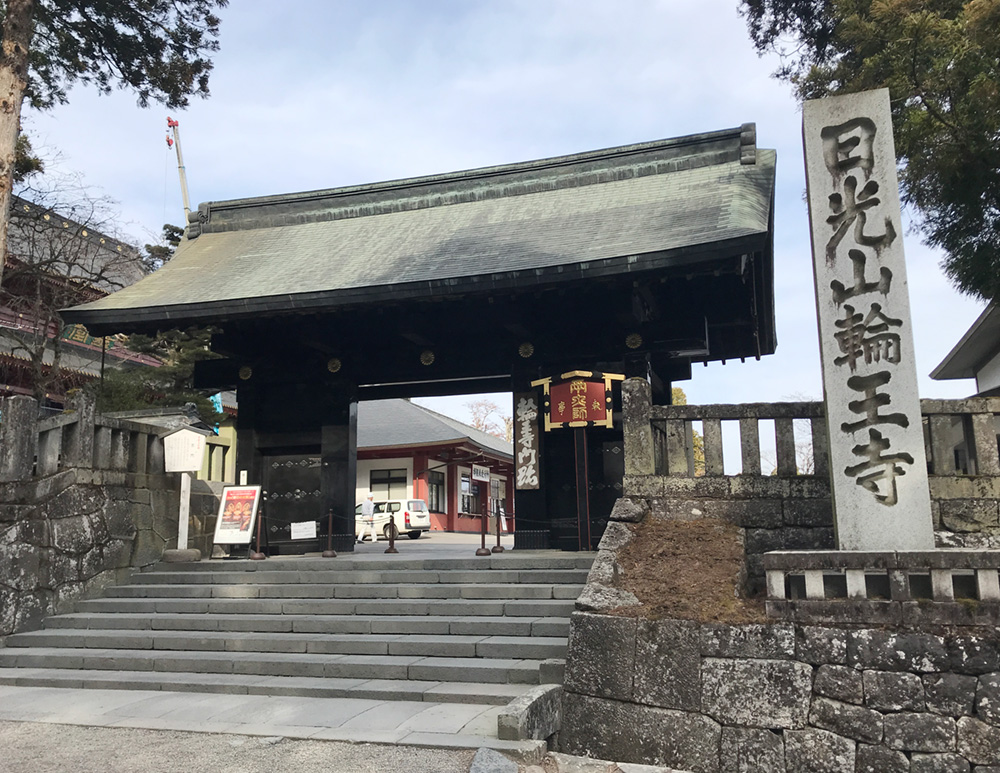黒門
Kuromon, Black Gate
黑门
黑門
구로몬, 검은 문
Kuromon, porte noire
Kuromon, Schwarzes Tor
Kuromon, la Puerta Negra
คุโรมง (Kuromon) - ประตูดำ

黒門は、日光山総本坊であった「光明院」の正門です。光明院は、江戸時代、日光山を中興した「天海」大僧正が日光山全体の総本坊(本部)として再興したお寺です。その当時、東照宮を含む日光全山は、皇族出身の僧侶「輪王寺宮法親王」によって治められ、さらに江戸時代を通じて輪王寺宮が比叡山と東叡山(上野)を併せた三山を管領することとなります。
光明院は延べ床面積約2,600坪(8,700m2)の大書院でしたが、神仏分離の混乱の際、明治4年(1871)5月13日の火災により大半が失われました。その際、この「黒門」は境内北側にある「護法天堂」とともに焼失を免れたため、光明院の往時を偲ぶ貴重な建物となっています。
Built in the early seventeenth century, the Kuromon was originally the main gate of the private quarters of Rinnoji Temple’s monzeki, who was a member of the imperial family, with authority over the highly important Kan’eiji Temple in Tokyo and Enryakuji Temple near Kyoto. His being resident in Nikko is testament to the historical and religious significance of Rinnoji Temple. The carvings of chrysanthemums on the gate are the imperial chrysanthemum crest reserved for use by the imperial family.
The Kuromon has served as the main gate to Rinnoji Temple since 1877, when the Hall of the Three Buddhas was relocated here. The Hall previously stood near Nikko Futarasan Shrine and was moved here after the 1871 fire in which the monzeki's private quarters burnt down. The Kuromon and the nearby Gohotendo Hall are all that remain of the monzeki's estate.
黑门建于17世纪初,原本是轮王寺的“门迹”的私人住所正门。门迹是皇室成员,同时管理着非常重要的东京宽永寺和位于京都附近的延历寺。其居住于日光一事印证了轮王寺的历史和宗教意义。大门上的菊纹雕刻是日本皇室专属的菊纹家徽。
自1877年三佛堂迁移至此,黑门一直是轮王寺的正门。大殿曾伫立于日光二荒山神社附近,1871年大火烧毁了门迹的私人住所后被迁至此地。黑门和其附近的护法天堂都是门迹住所的遗迹。
黑門建於17世紀初,原本是輪王寺的“門跡”的私人住所正門。門跡是皇室成員,同時管理著非常重要的東京寬永寺和位於京都附近的延曆寺。其居住於日光一事印證了輪王寺的歷史和宗教意義。大門上的菊紋雕刻是日本皇室專屬的菊紋家徽。
自1877年三佛堂遷移至此,黑門一直是輪王寺的正門。大殿曾佇立於日光二荒山神社附近,1871年大火燒毀了門跡的私人住所後被遷至此地。黑門和其附近的護法天堂都是門跡住所的遺跡。
17세기 초에 지어진 구로몬은 원래 황실의 일원이며 도쿄의 칸에이지 사찰과 교토 인근의 엔랴쿠지 사찰에서 매우 중요한 지위에 있는 린노지 사찰 몬제키의 사유지 정문이었습니다. 몬제키가 닛코에 거주한 것은 린노지 사찰의 역사적, 종교적 중요성을 나타냅니다. 문에 새겨진 국화 조각은 황실 일원만 사용할 수 있는 황실 국화 문장입니다.
구로몬은 삼불당이 이곳으로 이전된 1877년부터 린노지 사찰의 정문으로 사용되었습니다. 전에는 닛코 후타라산 신사 근처에 있었는데, 1871년에 화재로 몬제키의 사유지가 소실된 이후 이곳으로 옮겨졌습니다. 몬제키의 사유지에서 구로몬과 인근의 고호텐도만이 남아 있습니다.
Construite au début du XVIIe siècle, la porte Kuromon était à l'origine la porte principale des quartiers privés du monzeki du temple Rinnō-ji, qui était membre de la famille impériale et avait autorité sur le très important temple Eiji’Kan à Tokyo et le temple Enryaku-ji près de Kyoto. Le fait qu'il ait résidé à Nikkō témoigne de l'importance historique et religieuse du temple Rinnō-ji. Les sculptures de chrysanthèmes sur la porte représentent le chrysanthème impérial, emblème réservé à l'usage de la famille impériale.
La porte Kuromon servit de porte principale au temple Rinnō-ji à partir de 1877, lorsque le hall des Trois Bouddhas y fut déplacé. Le hall se trouvait auparavant près du sanctuaire Nikkō Futarasan et fut déplacé ici après l'incendie de 1871 pendant lequel les quartiers privés du monzeki brûlèrent. La porte Kuromon et le hall Gohotendō voisin sont tout ce qu’il reste du domaine du monzeki.
Erbaut im frühen siebzehnten Jahrhundert, war das Kuromon ursprünglich das Haupttor, hinter dem sich die Privatgemächer des Monzeki vom Rinnoji-Tempel befanden, der ein Mitglied der kaiserlichen Familie und auch Oberhaupt der sehr wichtigen Tempel Kan‘eiji in Tokio und Enryakuji Nahe Kyoto war. Dass er in Nikko residierte, ist ein Beweis für die historische und religiöse Bedeutung des Rinnoji-Tempels. Die Chrysanthemen-Schnitzereien am Tor stellen das kaiserliche Chrysanthemenwappen dar, das der kaiserlichen Familie vorbehalten ist.
Das Kuromon dient seit 1877, als die Halle der drei Gottheiten hierher verlegt wurde, als Haupttor des Rinnoji-Tempels. Die Halle stand zuvor in der Nähe des Nikko Futarasan-Schreins und wurde nach dem Brand von 1871, bei dem die Privatgemächer des Monzekisniedergebrannt sind, hierher verlegt. Das Kuromon und die nahe gelegene Gohotendo-Halle sind alles, was vom Anwesen des Monzekis übriggeblieben ist.
Construida a principios del siglo XVII, la Kuromon era originalmente la puerta principal de los aposentos privados del monzeki del templo Rinnoji, un miembro de la familia imperial que tenía autoridad sobre los notables templos Kan’eiji de Tokio y Enryakuji, cerca de Kioto. El hecho de que el monzeki residiera en Nikko atestigua el significado histórico y religioso del templo Rinnoji. Las tallas de crisantemos de la puerta son el escudo del crisantemo imperial, reservado para el uso de la familia imperial.
La Kuromon ha servido como puerta principal del templo Rinnoji desde 1877, cuando el Pabellón de los Tres Budas se trasladó aquí. Anteriormente, el pabellón estaba cerca del santuario Nikko Futarasan y se trasladó después del incendio de 1871 en el que se quemaron las habitaciones privadas del monzeki. La Kuromon y el cercano Pabellón Gohotendo son todo lo que queda de la finca del monzeki.
ประตูนี้สร้างขึ้นในช่วงต้นศตวรรษที่ 17 แต่เดิมประตูคุโรมง (Kuromon) เป็นประตูหลักของอาณาเขตส่วนตัวของมอนเซกิ (Monzeki) ของวัดรินโนจิ (Rinnoji) ซึ่งเป็นสมาชิกของราชวงศ์ที่มีอำนาจเหนือวัดที่มีความสำคัญมากอย่างเช่น วัดคันเอจิในโตเกียว และวัดเอ็นเรียกุจิที่อยู่ใกล้เกียวโต การอาศัยอยู่ของท่านที่นิกโก เป็นเครื่องพิสูจน์ได้ดีถึงความสำคัญทางประวัติศาสตร์และศาสนาของวัดรินโนจิ การแกะสลักดอกเบญจมาศที่ประตู เป็นยอดดอกเบญจมาศจักรพรรดิที่สงวนไว้สำหรับใช้โดยราชวงศ์
ประตูคุโรมงถูกใช้เป็นประตูหลักของวัดรินโนจิตั้งแต่ปี ค.ศ. 1877 เมื่อได้ย้ายวิหารของพระพุทธเจ้าทั้งสามองค์มาที่นี่ ซึ่งแต่เดิมวิหารตั้งอยู่ใกล้กับศาลเจ้านิกโกฟูตาราซัง (Nikko Futarasan) และถูกย้ายมาที่นี่หลังจากเกิดอัคคีภัยในปี ค.ศ. 1871 ซึ่งอาณาเขตส่วนตัวของมอนเซกิถูกไฟไหม้ ประตูคุโรมงและหอโกโฮเท็นโด (Gohotendo) ที่อยู่ใกล้เคียงล้วนเป็นทรัพย์สมบัติของมอนเซกิ
